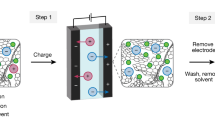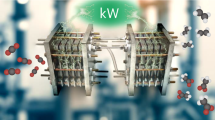Abstract
During the past decade it has been shown conclusively that the incineration of municipal and industrial wastes gives rise to emissions of chlorinated dibenzodioxins and dibenzofurans. However, the mechanism by which these toxic compounds are formed has not yet been fully established. Some researchers believe that the presence of organically bound chlorine is necessary1, but others consider that inorganic forms of chlorine may also participate in the process2. We now report the synthesis of a large number of chlorinated environmental pollutants in a simple high-temperature experiment. The results show that phenol and HCl are the most likely precursors of the chlorinated dibenzodioxins and dibenzofurans formed in the combustion of wastes. The depen-dence of the reaction on the concentration of HCl indicates a way of controlling the formation of these toxic compounds during incineration.
This is a preview of subscription content, access via your institution
Access options
Subscribe to this journal
Receive 51 print issues and online access
$199.00 per year
only $3.90 per issue
Buy this article
- Purchase on Springer Link
- Instant access to full article PDF
Prices may be subject to local taxes which are calculated during checkout
Similar content being viewed by others
References
Rappe, Ch., Markland, S., Buser, H. R. & Bosshard, H. P. Chemosphere 7, 269–277 (1978).
Bumb, R. R. et al. Science 210, 385–390 (1980).
Author information
Authors and Affiliations
Rights and permissions
About this article
Cite this article
Eklund, G., Pedersen, J. & Strömberg, B. Phenol and HCl at 550 °C yield a large variety of chlorinated toxic compounds. Nature 320, 155–156 (1986). https://doi.org/10.1038/320155a0
Received:
Accepted:
Issue Date:
DOI: https://doi.org/10.1038/320155a0
Comments
By submitting a comment you agree to abide by our Terms and Community Guidelines. If you find something abusive or that does not comply with our terms or guidelines please flag it as inappropriate.



